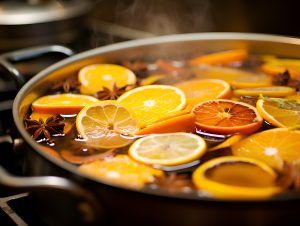Poached Chicken à la You
Poached Chicken à la You

We all get in cooking ruts. Often, it’s not just a new recipe that you need to get out of the rut, it’s an entirely new method of cooking that is what you need to get your creative juices flowing. We’ve all enjoyed poached eggs, but have you tried to poach anything else? This simple recipe for Poached Chicken à la You is limited only by your creativity. It’s something you can make again and again, experimenting and tweaking the recipe each time.
Poaching
Poaching is a cooking technique that involves gently simmering food in liquid at a low temperature for an extended period of time. It is a simple yet elegant way to cook a variety of foods, infusing them with delicate flavors while retaining their tenderness and moisture. Poaching provides several benefits compared to traditional cooking methods, including preserving the natural flavors and nutrients of foods, and creating a healthy oil-free alternative to frying or even sautéing.
When it comes to poaching, it’s important to choose the right liquid to enhance the flavor of the dish. Two of the most common poaching liquids are wine and water. Each brings its own characteristics and can enhance the overall outcome of the dish. Wine, in particular, can add depth and complexity to the poaching liquid, while also tenderizing the meat or fish.
Cooking with Wine
Wine is often used to enhance the flavor of poached dishes. The subtle nuances of wine can add depth and complexity to poached foods, making them even more flavorful. When poaching with wine, it is important to choose a wine that pairs well with the ingredients being cooked. For example, white wine is often used to poach fish, while red wine is typically used for poaching red meats.
When poaching with wine, it is important to consider the alcohol content. Higher alcohol content can result in a more intense flavor, so it is best to choose a wine that is not overly alcoholic. It is also worth noting that the amount of wine used can vary depending on the type of food being poached.
To poach with wine, simply add the wine to the poaching liquid and bring it to a gentle simmer. It is important to ensure that the liquid stays at a low simmer throughout the entire poaching process to prevent overcooking the food. Once the food is cooked, remove the dish from the heat and let it rest for a few minutes to absorb the flavors of the poaching liquid.
While water and wine are most common, don’t stop there. You can poach with broth, tea, or even fruit juices. Again, the only limitation is your creativity.
Using Aromatics
Aromatics such as herbs, spices, and citrus zest can add another layer of flavor to poached dishes. These aromatics can be added directly to the poaching liquid or wrapped around the ingredients before poaching. When adding ground or powdered herbs to the poaching liquid, it is important to make sure they are fully dissolved before poaching the food.
Citrus zest, in particular, can add a refreshing citrus note to poached dishes. Simply add the zest to the poaching liquid and let it simmer for a few minutes to release its flavor. Other aromatics such as spices, such as bay leaves, can be added whole and removed before serving, or they can be crushed to release their flavors during the cooking process
Poaching techniques can be combined to create even more complex and flavorful dishes. One such technique is to sear the food before poaching. Searing the food creates a rich, caramelized crust, which adds depth to the finished dish. This technique is often used when poaching meat or fish to enhance the flavor and texture of the finished dish.
Don’t forget, poaching extends beyond breakfast and main courses. Poaching vegetables and fruit opens up a whole new world of tasty options as well!
Poached Chicken à la You
For this recipe, you will need skinless chicken breasts, white wine, garlic, and herbs.
In a medium-sized pot, combine the white wine, garlic, and herbs. Bring the mixture to a simmer over medium heat. For your first time out select whatever herbs you usually enjoy with chicken. Or throw caution to the wind and try something new or a new combination.
Once the mixture is simmering, add the chicken breasts, ensuring they are completely covered in the liquid.
Cover the pot with a lid and cook at low to medium heat for 10-15 minutes, or until the chicken is cooked through. Overcooking will lead to dry chicken even though you’re cooking in liquid.
Remove the chicken breasts from the poaching liquid and let them rest for a few minutes.
Use the poaching liquid as an au jus or the base for gravy or serve the chicken with your favorite sides or a dipping sauce. Enjoy Poached Chicken à la You!
- SHARE THIS POST


